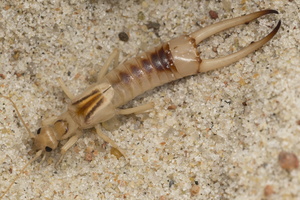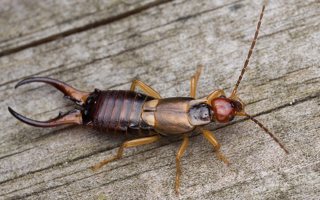
- еarwigs
- Ohrwürmer
- auslindos
- spīļastes
- skorki, cęgosze
https://en.wikipedia.org/wiki/Earwig Earwigs have characteristic cerci, a pair of forcep-like pincers on their abdomen, and membranous wings folded underneath short, rarely used forewings, hence the scientific order name, "skin wings". Some groups are tiny parasites on mammals and lack the typical pincers. Earwigs are found on all continents except Antarctica.
Earwigs are mostly nocturnal and often hide in small, moist crevices during the day, and are active at night, feeding on a wide variety of insects and plants. Damage to foliage, flowers, and various crops is commonly blamed on earwigs, especially the common earwig Forficula auricularia.
Earwigs have five molts in the year before they become adults. Many earwig species display maternal care, which is uncommon among insects. Female earwigs may care for their eggs; the ones that do will continue to watch over nymphs until their second molt. As the nymphs molt, sexual dimorphism such as differences in pincer shapes begins to show.
There is no evidence that they transmit disease or otherwise harm humans, despite their nickname pincher bug. Earwigs are omnivores, generally nocturnal and tend to gather in shady cracks or openings or anywhere that they can remain concealed in daylight hours.
Tai vabzdžiai, pilvelio gale turintys žnyplių pavidalo cerkus. Burnos organai graužiamieji, antenos siūliškos. Antsparniai sutrumpėję, kieti. Užpakaliniai sparnai plėviški, pusskritulio formos. Kojos bėgiojamosios. Metamorfozė nepilna. Dauguiausia naktiniai gyvūnai. Minta augalinėmis ir gyvūninėmis liekanomis, kartais apgraužia žiedus, lapus, vaisius.

